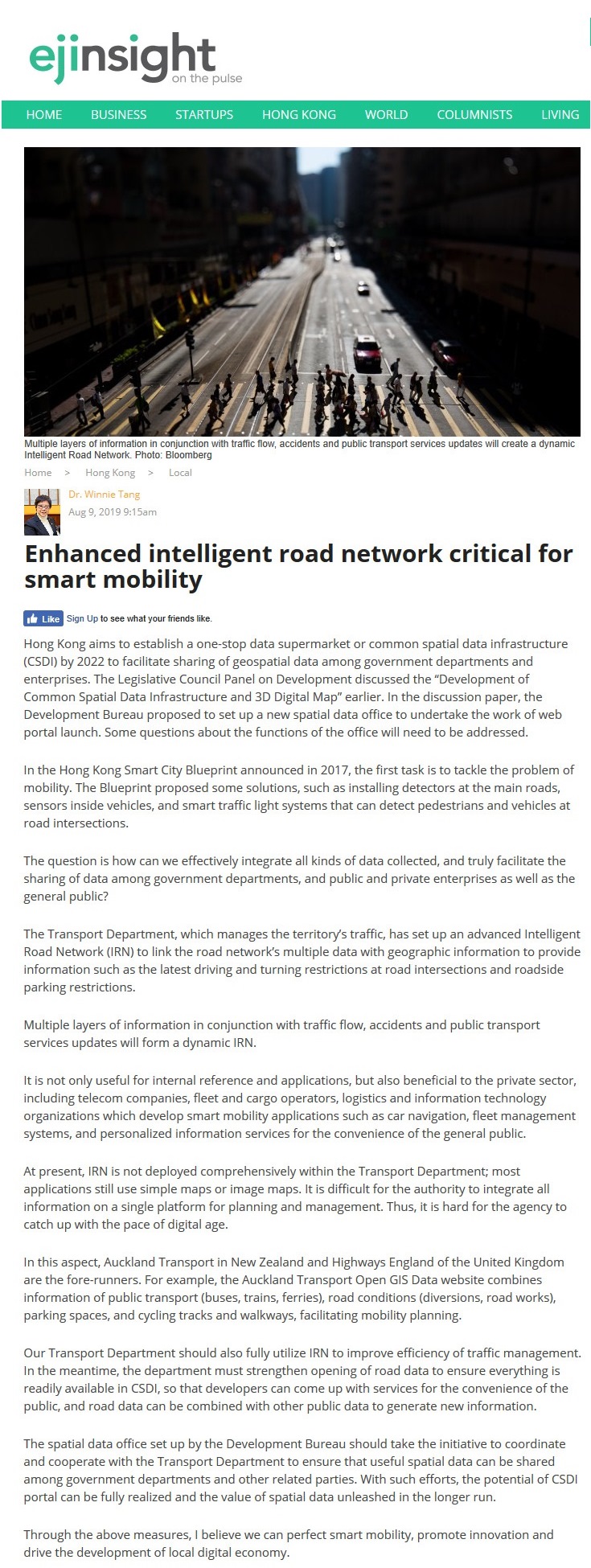網上版請按此

Enhanced intelligent road network critical for smart mobility
Hong Kong aims to establish a one-stop data supermarket or common spatial data infrastructure (CSDI) by 2022 to facilitate sharing of geospatial data among government departments and enterprises. The Legislative Council Panel on Development discussed the "Development of Common Spatial Data Infrastructure and 3D Digital Map" earlier. In the discussion paper, the Development Bureau proposed to set up a new spatial data office to undertake the work of web portal launch. Some questions about the functions of the office will need to be addressed.
In the Hong Kong Smart City Blueprint announced in 2017, the first task is to tackle the problem of mobility. The Blueprint proposed some solutions, such as installing detectors at the main roads, sensors inside vehicles, and smart traffic light systems that can detect pedestrians and vehicles at road intersections.
The question is how can we effectively integrate all kinds of data collected, and truly facilitate the sharing of data among government departments, and public and private enterprises as well as the general public?
The Transport Department, which manages the territory's traffic, has set up an advanced Intelligent Road Network (IRN) to link the road network's multiple data with geographic information to provide information such as the latest driving and turning restrictions at road intersections and roadside parking restrictions.
Multiple layers of information in conjunction with traffic flow, accidents and public transport services updates will form a dynamic IRN.
It is not only useful for internal reference and applications, but also beneficial to the private sector, including telecom companies, fleet and cargo operators, logistics and information technology organizations which develop smart mobility applications such as car navigation, fleet management systems, and personalized information services for the convenience of the general public.
At present, IRN is not deployed comprehensively within the Transport Department; most applications still use simple maps or image maps. It is difficult for the authority to integrate all information on a single platform for planning and management. Thus, it is hard for the agency to catch up with the pace of digital age.
In this aspect, Auckland Transport in New Zealand and Highways England of the United Kingdom are the fore-runners. For example, the Auckland Transport Open GIS Data website combines information of public transport (buses, trains, ferries), road conditions (diversions, road works), parking spaces, and cycling tracks and walkways, facilitating mobility planning.
Our Transport Department should also fully utilize IRN to improve efficiency of traffic management. In the meantime, the department must strengthen opening of road data to ensure everything is readily available in CSDI, so that developers can come up with services for the convenience of the public, and road data can be combined with other public data to generate new information.
The spatial data office set up by the Development Bureau should take the initiative to coordinate and cooperate with the Transport Department to ensure that useful spatial data can be shared among government departments and other related parties. With such efforts, the potential of CSDI portal can be fully realized and the value of spatial data unleashed in the longer run.
Through the above measures, I believe we can perfect smart mobility, promote innovation and drive the development of local digital economy.
Dr. Winnie Tang
Adjunct Professor, Department of Computer Science, Faculty of Engineering and Faculty of Architecture, The University of Hong Kong